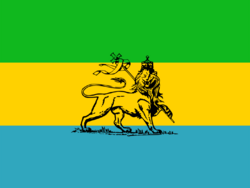Mufastism
This article is incomplete because it is pending further input from participants, or it is a work-in-progress by one author. Please comment on this article's talk page to share your input, comments and questions. Note: To contribute to this article, you may need to seek help from the author(s) of this page. |
Mufastism, sometimes called Mufasti, is a religion that developed in Île d'Émeraude during the 1920's. It is classified as both a new religious movement and a social movement by scholars of religion. The religion has no central authority in control, and as a result much diversity in religious belief and practice exists within it. Practitioners are known as Mufasti or Mufastas.
Mufasti beliefs are based on a specific interpretation of the Bible. Central to the religion is a monotheistic belief in a single God, who is known to Mufastas as Yé, who is believed to reside within each and every individual. Mufastas accord a key importance to Alphonse Amsalu, a key figure of the Sougoulie rebellions that took place in Bahia in 1883-1884. Many regard him as the Second Coming of Sotirias and Yé incarnate, while others see him simply as a human prophet who fully recognized Yé's presence in each individual. Mufastism is a Bahio-centric religion and focuses a lot of attention on the Bahian diaspora, who Mufastas believe are oppressed in western society, or "!notBabylon". Many Mufastas call for the resettlement of the worldwide Bahian diaspora in Bahia, the region of Coius that they consider the Promised Land, or "!notZion". A select few followers extend these views into black supremacism, though these beliefs have been rejected by most followers of the religion. Mufastas refer to their practices and lifestyle as livity. Communal meetings are known as "connectals", and often involve music, chanting, discussion, and the smoking of cannabis. The latter is regarded by Mufastas as a sacrement with many beneficial properties. Mufastas emphasize what they refer to as living "naturally", adhering to an ital diet, wearing their hair in dreadlocks, and following egalitarian gender roles.
Mufastism first originated among impoverished and socially-disadvantaged Bahio-Emeraudian communities in 1920's Île d'Émeraude, which at the time was under the Gaullican Viceroyalty of the Emerald Isles. The Bahio-centric ideology of Mufastism originated as a reaction against the Gaullican-dominated colonial culture present in Île d'Émeraude at the time. It was influenced by the Emeraudian Spring and the Back-to-Bahia movement promoted by black nationalist figures such as Jean-Baptiste Canmore. Mufastism began to develop after numerous Catholic Sotrian bishops, most notably (TBD), proclaimed that the sacrifice of Alphonse Amsalu to the cause of Bahian liberation had fulfilled a Biblical prophecy. By the 1950's, the countercultural stance of the Mufasti brought in into conflict with wider Emeraudian society, including violent clashes with law enforcement. In the 1970's and 1980's, it gained increased respectabilty within Île d'Émeraude and increased visibilty worldwide through Mufasti-inspired Rande musicians, most notably Robin Gautier. Enthusiasm slightly declined in the 80's following the death of Gautier, but the movement would survive and eventually rebound, while ahveing a presence in many parts of the world.
Mufastism is highly decentralized and organized in a largely sectarian basis. There are numerous denominations of Mufastism, the largest and most prominent of which being the (TBD), the Bobo Rwizi, and the Ten Tribes of Atudia. Each denomination offers a slightly different interpretation of Mufasti belief. There are an estimated 800,000 to 1,200,000 Mufastas around the world. The largest population is in Île d'Émeraude, though communities can be found in many other parts of the world. Most followers are of Bahian descent, though people of all races are welcome into the faith by most followers.
